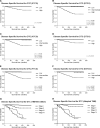Evaluating Disease-specific Survival Prediction of Risk Stratification and TNM Systems in Differentiated Thyroid Cancer
- PMID: 36508298
- PMCID: PMC10188308
- DOI: 10.1210/clinem/dgac721
Evaluating Disease-specific Survival Prediction of Risk Stratification and TNM Systems in Differentiated Thyroid Cancer
Abstract
Background: Many countries have national guidelines for the management of differentiated thyroid cancer (DTC), including a risk stratification system to predict recurrence of disease. Studies whether these guidelines could also have relevance, beyond their original design, in predicting survival are lacking. Additionally, no studies evaluated these international guidelines in the same population, nor compared them with the TNM system. Therefore, we investigated the prognostic value of 6 stratification systems used by 10 international guidelines, and the TNM system with respect to predicting disease-specific survival (DSS).
Methods: We retrospectively studied adult patients with DTC from a Dutch university hospital. Patients were classified using the risk classification described in the British, Dutch, French, Italian, Polish, Spanish, European Society of Medical Oncology, European Thyroid Association, the 2009 and 2015 American Thyroid Association (ATA) guidelines, and the latest TNM system. DSS was analyzed using the Kaplan-Meier method, and the statistical model performance using the C-index, Akaike information criterion, Bayesian information criterion, and proportion of variance explained.
Results: We included 857 patients with DTC (79% papillary thyroid cancer, 21% follicular thyroid cancer). Median follow-up was 9 years, and 67 (7.8%) died because of DTC. The Dutch guideline had the worst statistical model performance, whereas the 2009 ATA/2014 British guideline had the best. However, the (adapted) TNM system outperformed all stratification systems.
Conclusions: In a European population of patients with DTC, of 10 international guidelines using 6 risk of recurrence stratification systems and 1 mortality-based stratification system, our optimized age-adjusted TNM system (8th edition) outperformed all other systems.
Keywords: ATA guideline; TNM; follicular thyroid cancer; papillary thyroid cancer; prognosis; survival.
© The Author(s) 2022. Published by Oxford University Press on behalf of the Endocrine Society.
Figures
References
-
- La Vecchia C, Malvezzi M, Bosetti C, et al. . Thyroid cancer mortality and incidence: a global overview. Int J Cancer. 2015;136(9):2187‐2195. - PubMed
-
- Davies L, Welch HG. Increasing incidence of thyroid cancer in the United States, 1973-2002. JAMA. 2006; 295(18):2164‐2167. - PubMed
-
- Haugen BR, Alexander EK, Bible KC, et al. . 2015 American Thyroid Association management guidelines for adult patients with thyroid nodules and differentiated thyroid cancer: the American Thyroid Association guidelines task force on thyroid nodules and differentiated thyroid cancer. Thyroid. 2016; 26(1):1‐133. - PMC - PubMed
-
- Pacini F, Schlumberger M, Dralle H, et al. . European consensus for the management of patients with differentiated thyroid carcinoma of the follicular epithelium. Eur J Endocrinol. 2006;154(6):787‐803. - PubMed
MeSH terms
LinkOut - more resources
Full Text Sources
Medical
Research Materials


